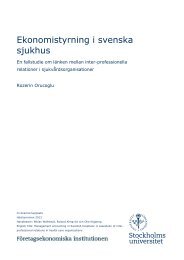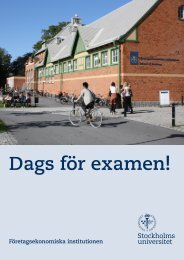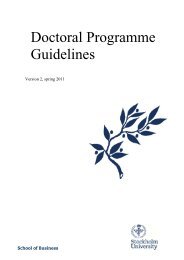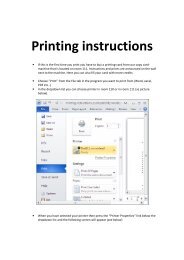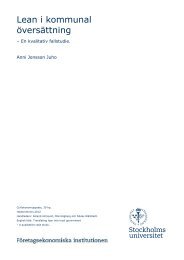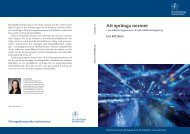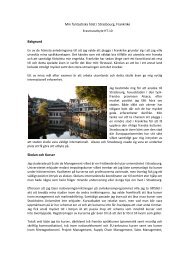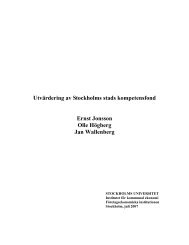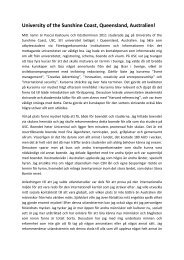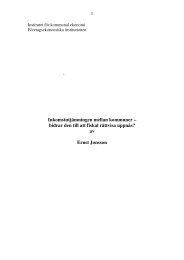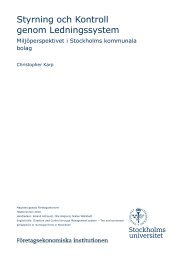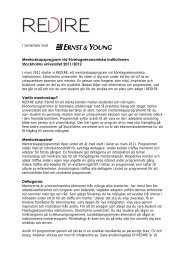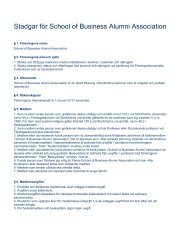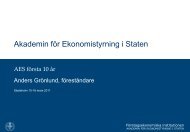Download full programme and abstract book pdf 1.6
Download full programme and abstract book pdf 1.6
Download full programme and abstract book pdf 1.6
Create successful ePaper yourself
Turn your PDF publications into a flip-book with our unique Google optimized e-Paper software.
28:01<br />
Real learning through real projects for management students:<br />
project-based learning for innovation <strong>and</strong> change<br />
Mårtensson, Pär 1 ; Sannes, Ragnvald 2<br />
1 Stockholm School of Economics, Management <strong>and</strong><br />
Organization, Stockholm, Sweden; 2 BI Norwegian Business<br />
School, Department of Leadership <strong>and</strong> Organisational<br />
Behaviour, Oslo, Norway<br />
Many organizations use projects as means to accomplish<br />
various forms of innovation <strong>and</strong> change. These task are often<br />
temporal, cross-sectional (or inter-organizational), complex<br />
<strong>and</strong> novel tasks that put them outside the capability of the line<br />
organization. Innovation <strong>and</strong> change describe combined efforts<br />
of development or adoption of something new (innovation)<br />
<strong>and</strong> the implementation of the innovation to an organizational<br />
context (change).<br />
Projects tend to be more successful in organizational contexts<br />
that have developed project management capabilities <strong>and</strong> a<br />
culture that foster learning across projects (Swan, Scarbrough<br />
& Newell, 2010). Organizations learn from projects by the<br />
accumulated experience of groups <strong>and</strong> individuals (ibid).<br />
Studies on knowledge transfer in problem-solving point to<br />
similar findings where knowledge is transferred by individuals<br />
<strong>and</strong> groups sharing experiences during problem-solving<br />
activities.<br />
These results indicate that project-based learning is a feasible<br />
approach for management students to learn about innovation<br />
<strong>and</strong> change. In this paper we explore <strong>and</strong> explain the use of<br />
real projects to teach innovation <strong>and</strong> change to management<br />
students. Based on more than 15 years of experience in<br />
the area, the paper presents an empirical examination of<br />
project characteristics <strong>and</strong> learning outcomes across different<br />
educational contexts.<br />
The study indicates that the more ”real” a management<br />
student project is, the better outcome in terms of learning<br />
of the subjects at h<strong>and</strong>. Executive students tend to have<br />
more ”real” projects than younger <strong>full</strong>-time students. One<br />
possible explanation is that executive students come from<br />
organizational contexts where they relatively easy can identify<br />
problems <strong>and</strong> opportunities. Another factor may be their<br />
experience by itself, helping them to formulate more focused<br />
problem statements for a project. The study also discusses the<br />
”realness” of the projects used in relation to the business value<br />
through innovation <strong>and</strong> change created by the projects. Finally<br />
the papers discuss the influence by different stakeholders of the<br />
projects <strong>and</strong> how this impacts the learning.<br />
The paper ends with some concluding remarks outlining<br />
mechanisms to take into consideration when designing real<br />
learning through real projects for management students.<br />
Reference:<br />
Swan, J., Scarbrough, H. <strong>and</strong> Newell, S. (2010). 2Why Don’t<br />
(or Do) Organizations Learn from Projects?”, Management<br />
Learning, Vol 41 No 3, pp. 325-344.<br />
28:02<br />
Facec<strong>book</strong> - A new approach for educational practice<br />
Ossiansson, Eva<br />
School of Business, Economics & Law, Gothenburg University,<br />
Marketing, Gothenburg, Sweden<br />
For young people between 15-24 years of age, Internet<br />
<strong>and</strong> Social Media has become a natural part of their lives.<br />
Recent studies have acknowledged this <strong>and</strong> researchers have<br />
increasingly become interested in how young people use<br />
social media. By studying usage of social networks such as<br />
Face<strong>book</strong> in a pedagogical setting, group dynamics, norms<br />
<strong>and</strong> interactions can be analyzed. For example, one study has<br />
found that there is a strong link between an individual’s social<br />
140<br />
identity, group norm <strong>and</strong> subjective norm. Thus, underst<strong>and</strong>ing<br />
norms are essential if social media is to be used in an<br />
educational setting. This is important given the current debate<br />
on whether social media is a suitable learning environment.<br />
Problems in this area that has been debated are often authority<br />
related; lecturer-student power relations, lecturer code of<br />
conduct <strong>and</strong> technical skills.<br />
In this paper, we intend to analyze how norms develop <strong>and</strong><br />
influence student communication (peer-to-peer, group wise,<br />
between groups, the class as a community) <strong>and</strong> student-lecturer<br />
interaction. In a master course, - a closed Face<strong>book</strong> group was<br />
used for the class communication. The Face<strong>book</strong> group was the<br />
single use for communication outside the class room, eg. time<br />
schedule, changes in class, <strong>book</strong>ing supervision time etc. It was<br />
also used as a forum for students’, lecturers’ <strong>and</strong> practitioners’<br />
discussions about the literature, interesting news, films as well<br />
as social interaction.<br />
Our conclusions are that the usage of social media as a<br />
communication platform really changed the norms for<br />
interaction <strong>and</strong> enhanced all forms of communication.<br />
Students took an active part of sharing additional literature,<br />
articles <strong>and</strong> films relevant for the course. As the course went<br />
on communication changed more towards communication<br />
“among equals”. Students saw themselves as co-creators<br />
of the course, along with the lecturer responsible for the<br />
course. Therefore, a coach-based authority emerged. Even<br />
though students initially doubted whether they should take<br />
responsibility for their own learning <strong>and</strong> participation or not,<br />
this gradually changed when using Face<strong>book</strong>. In line with<br />
traditional Face<strong>book</strong> usage the class members increasingly<br />
saw themselves as a group. Thus, we see this as a promising<br />
research area with great potential for educational relevance.<br />
28:03<br />
The bobsleigh approach in business administration education<br />
Jonnergård, Karin; Boye, Petter<br />
Linnaeus University, School of Business <strong>and</strong> Economics,<br />
Kalmar, Sweden<br />
The main issue taken up in this paper is how resources are<br />
allocated in higher educational programs – in the beginning or<br />
in the end of the process. Today, higher educational programs<br />
in business administration normally spend more resources per<br />
student at the end of the program than at the beginning. There<br />
are several possible rationalities for this, for example that<br />
higher levels are more advanced <strong>and</strong> therefore require more<br />
resources or that there are fewer students at the higher levels<br />
than at the lower levels, making it harder to obtain economies<br />
of large scale. We can, however, see that many students fail<br />
the exam because they do not have the necessary knowledge<br />
needed to comprehend the next knowledge module. This,<br />
in turn leads to a situation were teaching resources at the<br />
end of the educational program are used for repetition <strong>and</strong><br />
for h<strong>and</strong>ling extra exams, etc. Consequently the resources<br />
are not used as intended <strong>and</strong> the students cannot utilize this<br />
learning opportunity to the <strong>full</strong> extent. The purpose in this<br />
paper is to propose the ’Bobsleigh approach’ as a new way<br />
to look at resources allocation in business administration<br />
education in order to better underst<strong>and</strong> opportunities for<br />
increased effectiveness in such higher educational programs.<br />
It is important to reconsider the resource allocation in higher<br />
educational programs in business administration, as the results<br />
from the study reported in this paper indicates that resources<br />
allocated from the end to the beginning of the process will<br />
increase educational effectiveness <strong>and</strong> boost students learning<br />
outcomes in the end of the program. This paper is mainly<br />
based on an explorative study of the development of a higher<br />
educational program in business administration at the Linnaeus<br />
University. The empirical foundation is a longitudinal case<br />
study (Yin, 1994) of the development process, carried out



